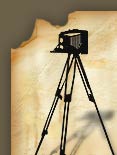

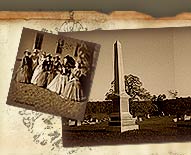





Basics of Stereo Photography
|
So you must be asking yourself, "What is this stereo picture stuff and how does it work?"
Sit back and relax and we'll explain it to you right now.
Welcome to SP101!
How Do I Perceive Depth?Let's start with the picture below. You can see that the star is in front of the door. This is one way that you perceive depth called "interposition". All this means is that you know, when two objects are one in front of the other, the front one is closer and the back one is further away. Simple, right? 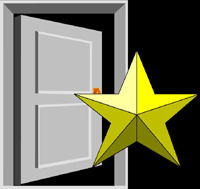 You also perceive depth by the size of objects. Look at the next image. In this picture, you know that the man on the left is closer than the man on the right because he is larger than the other.  Another way you perceive depth is through colors and shading. Take a look at the picture below. Notice that you know that the mountains are further away than the building, not only because the mountains are behind the building, but because of their haziness. Haze and lack of detail tell you that an object is further away than an object that is seen more clearly. Notice how the rocks and trees on the mountain get dimmer toward the left side of the image, showing you that the mountain is getting further away as it fades off into the distance. 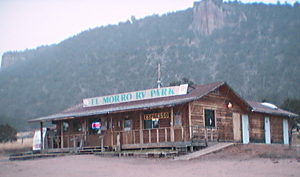 Now for the most vivid and striking way that you perceive depth: technically referred to as "retinal disparity". Having two eyes allows you to perceive depth to this degree. (hint: stereo photography will provide you with this type of perception in pictures) Your eyes are naturally separated by about three inches, giving you two slightly different views of whatever you are looking at. Your brain takes these two views and processes them into a true three dimensional (3D) image. The image below demonstrates how this form of depth perception works. As you look at the row of well behaved puppy dogs, your left eye "sees" the white puppy to the right of the brown puppy (that is actually behind). Your right eye "sees" the white puppy to the left of the brown puppy. Your brain puts those two images together and you see a 3D view of the two puppies, one behind the other. 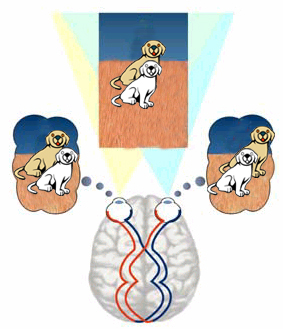 How Are Stereo Pictures Taken?Now that you've learned how depth is perceived, you're ready to move on to how they are made. When we try to capture 3D in pictures, we become limited in our capabilities. When you look at a single picture, like a snapshot or one of the images above, they do not appear three dimensional even though you look at them with both eyes. You may be able to make out some depth by interposition, size and shading, but you don't "see" the 3D depth. You need two different pictures to capture three-dimensional depth, one picture for each eye. The key to understanding stereo photography is just this; two images are required in order to present each of your eyes with a slightly different view of one object or scene. Each of the two images are different because they represent the view from the position of each eye, as if you were looking at the real deal of whatever is being shown in the pictures. Taking a stereo picture requires taking two pictures from slightly different places, a special camera, a camera with a splitter, or two separate cameras. See the examples below.
How in the World Do I Look at Two Pictures at the Same Time?That's a GREAT question! There are many ways to view stereo pictures. Oliver Wendell Holmes, one of photography's pioneers, developed a special two picture viewing card for stereo presentation. He pasted two pictures (taken from slightly different places as you learned already) onto a 3 ½ inch x 7 inch piece of cardboard that was designed to be fit into a special viewer. These viewers had lenses mounted in them making it easy for each of your eyes to focus on the two different pictures, each eye with each picture. This special viewer is called a "stereoscope" and Holmes turned it into a standard fixture in the "modern" parlor of his time. You may remember them from your Grandmother's parlor. Maybe you have even seen them in your friend's living rooms today. The stereoscope is coming back! See the stereopticons available from Vintage Visuals. Ever heard of the Viewmaster? You may have had one when you were younger. You popped in the round picture reels to view Niagara Falls, Hopalong Cassidy, Spiderman or Disney characters. Those reels were made up of stereo pictures. Did you ever wonder why there was two of every image? It's because there was one for each eye, creating the "magic" 3D picture that you saw in the viewer. So, the famous Viewmaster is another way to view photos in stereo! See, stereo photography isn't as foreign as you might have thought. 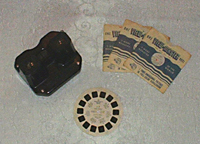 Okay, so here's another way to view two pictures at once that you're probably familiar with. Do you remember the blue and red 3D glasses from days of yore? Ah-the wonderful headaches that came from reading the 3D comic books and watching the 3D action movies with those wonderfully stylish glasses!  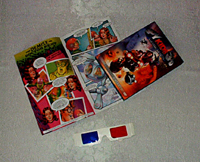 "How do they work", you ask? Well, it's like this---the two pictures are put on top of one another to make one picture. One of the two is printed in red and the other in blue. Add the glasses and one eye picks up the red picture while the other eye picks up the blue picture, giving you the 3D experience! And, just in case you're interested, the technical term for this type of picture is "anaglyph". Can't have a lesson without a few new terms now can we? The picture below is an example of an anaglyph. In its small size, there isn't much to see. Click on the picture to enlarge it now and you will clearly see the red and blue differences. To view this image in 3D, put your blue and red glasses on using the red filter on the left eye and the blue filter on the right eye. (You don't have any 3D glasses? Click here to order yours) Okay, let us point some things out in this anaglyph:
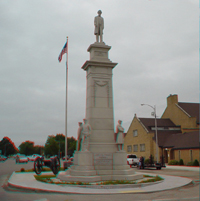 Amazing, isn't it? Just a little trick of the eyes with color differences and EVERYTHING changes from boring and flat to brilliant and full of life!! There are so many ways to view the beauty of life in its full glory and Vintage Visuals is here to help you to do just that. Wrap-up“Oh, infinite volumes of poems that I treasure in this small library
of glass and pasteboard! I creep over the vast features of Rameses, on the face of his rockhewn
Nubian temple; I scale the huge mountain-crystal that calls itself the Pyramid of Cheops... and
then I dive into some mass of foliage with my microscope, and trace the veinings of a leaf so
delicately wrought in the painting not made with hands, that I can almost see its down and the
green aphis that sucks its juices.” |
